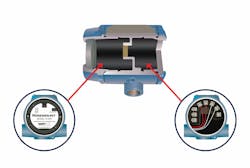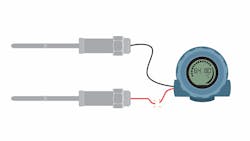In the list of sentences that operators and plant managers don’t want to hear, “We need to shut down the plant” ranks near the top of the list. Unplanned shutdowns can have a significant impact on the profitability of a business. Furthermore, accurate process measurements throughout an operation are critical to the quality, safety and yield of the process. That’s why continuous measurement in process control applications is essential. To operate continuously, users face two main challenges: performance optimization, ensuring sensors are working properly and electrical noise interference is minimized; and accuracy optimization, ensuring that the sensor physically accesses the most representative measurement point.
Temperature measurements can experience a multitude of issues that impact plant operation. Despite protective measures, sensors are prone to failure and degradation that can cause a loss of measurement integrity. Sensors can also have small voltages (known as thermal electromagnetic fields, or EMFs) build up in their wiring and can cause inaccuracies in temperature readings due to a resultant change in resistance.
In addition to issues with sensor failure and degradation, environmental factors can have a significant impact on the quality of a temperature reading received by the control system. Transmitter wiring can be susceptible to electrical noise and vibrations. Suboptimal conditions are commonly found in installations near blowers, pumps and compressors. Transient events such as lightning strikes or electrical discharges can cause inaccurate readings, which lead to false alarms. Such alarms can result in a shutdown of the process and require operations personnel to perform a check on the sensor.
Critical control or custody transfer applications, such as batch reactors, lease automatic custody transfer (LACT) skids, and safety loops require a high level of temperature measurement accuracy. Often, resistance temperature detector (RTD) sensors are used to take such measurements. These sensors work by measuring resistance changes in a temperature-sensitive alloy; and the accuracy of that correlation can be affected by errors and inconsistencies introduced during the sensor’s manufacture.
Accuracy of a temperature measurement can also be impacted by the immersion length of the thermowell used to protect the sensor. The highest level of accuracy and time response in a pipe application is obtained by inserting the tip of the thermowell (along with the tip of the sensing element) into the very center of the pipe. However, this goal is often not achieved, as thermowell length sometimes must be reduced to endure harsh process conditions and vibration stresses.
Emerson offers a range of solutions to help tackle these challenges and to better ensure continuous temperature measurement and operation. These include Transmitter-Sensor Matching, the Rosemount™ Twisted Square™ Thermowell, and a range of advanced diagnostic features included in Rosemount Temperature Transmitters.
Diagnostics for continuous temperature measurement
One of these features is Emerson’s Hot Backup™ Capability. This capability features a redundant, dual-input sensor configuration designed to mitigate the effects of a failed sensor. If the primary sensor fails, the transmitter will automatically switch to the secondary sensor.
The Hot Backup feature also displays an alert indicating that the primary sensor has failed so that it can be replaced. This capability is especially beneficial for critical applications where a failed sensor and subsequent lost measurement could cause safety concerns.
Emerson’s Rosemount Temperature Transmitters also offer several advanced diagnostic features to limit the impact of environmental conditions on the accuracy of a temperature measurement. One of those diagnostic features is transient filtering, which prevents intermittent transient signals (such as those resulting from an electrically noisy environment or high vibration) from affecting the measurement. By disregarding apparent temperature spikes, sensor signal interruption is prevented and the last known reliable temperature value continues to be transmitted, thus saving a potential process upset or trip condition.
Another useful diagnostic feature is Open Sensor Hold-Off. Based on calculations performed by the transmitter, this feature determines whether a high-voltage transient event (i.e., lightning or electrostatic discharge) or an actual open sensor event has occurred. Inaccurate open sensor conditions can cause unnecessary alarms. To avoid these alarms, the transmitter ignores the outlier and outputs the previously established value.
Additionally, Rosemount Temperature Transmitters are equipped with an electromagnetic field (EMF) compensation feature. This diagnostic analyzes sensor loops and compensates for the thermal EMFs, resulting in more accurate temperature readings.
Apart from their diagnostic features, Rosemount Temperature Transmitters are available in a variety of form factors and housing styles to optimize their performance based on the needs of the application. Of the available form factors, the field mount is the most robust design. This solution features a dual compartment housing, meaning that the device electronics are in a separate chamber from the terminal block. This helps prevent the presence of moisture (from humidity or other sources) and subsequent corrosion of the device electronics.
Precision-enhancing innovations for measurement accuracy
Thermowells that must be shortened from their optimal length to withstand an application’s process conditions necessarily forfeit some degree of accuracy. Emerson’s innovative solution, the Rosemount Twisted Square Thermowell, features a unique helical stem profile that reduces dynamic stresses by more than 90%. This reduction in vibrational effects allows for the tip of the thermowell to rest in the center region of the pipe, allowing for the most accurate measurement possible.
In some cases, users can live with the error associated with the actual resistance curve of an RTD. In critical control and custody transfer applications, however, this error can be detrimental to the plant’s operation. Fortunately, Emerson’s temperature transmitters have the option to be specified with a Transmitter-Sensor Matching option. Transmitter-Sensor Matching decreases the error associated with the total measurement by up to 75%.
‘This reduction in error is achieved by programming the four constants from the sensor’s Callendar-Van Dusen equation into the transmitter. When specified with the Transmitter-Sensor Matching option, Emerson programs the transmitter with the appropriate constants from the factory, allowing users to achieve highly accurate temperature measurements that reliably optimize operational performance.


